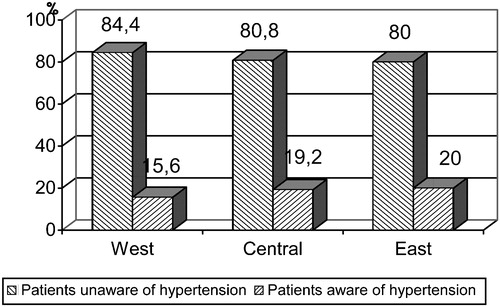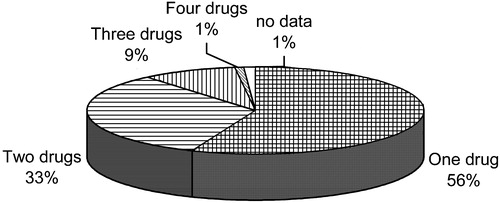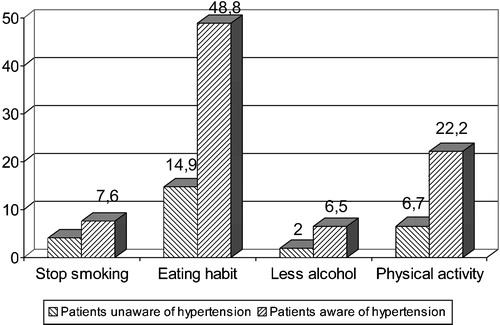Abstract
Hypertension is an important risk factor for cardiovascular diseases. An epidemiological survey in 1985 found that the prevalence of hypertension in Slovenia was comparable to rates reported from western European countries. Awareness of hypertension was poor and only a small fraction of patients had their blood pressure under satisfactory control. Since 1985, few population studies have been completed; the results suggest that little progress has been made in the field of hypertension control. The responsibility for the situation lies partly with family physicians, who often fail to react properly to uncontrolled blood pressure. Data from the last CINDI survey conducted in 2004 are more encouraging. Apparently, physicians now provide their patients with more information on how to attain their target blood pressure, and the percentage of hypertensive patients with controlled blood pressure seems to have increased. However, these are only assumptions, which should be verified by a nationwide epidemiological study. A pilot survey involving a random sample of the Slovenian adult population (about 11,000 subjects) is in progress and will be completed by the end of the year 2005.
Introduction
Hypertension is one of the most important risk factors for cardiovascular disease, which is the leading cause of death in Slovenia Citation[1]. An epidemiological survey in 1985 Citation[2], Citation[3] showed that 18.9% of the adult inhabitants of Slovenia had increased blood pressure (⩾160/95 mmHg). The prevalence of hypertension in different parts of the country ranged from 17% to 24% Citation[4], Citation[5]. As many as 22% of hypertensive patients were unaware of their condition, and only 30% of treated hypertensive patients had their blood pressure under adequate control (Table ).
Table I. Awareness and control of hypertension in Slovenia, 1985.
Over the past two decades, the CINDI programme has provided some valuable information on hypertension in Slovenia Citation[6], Citation[7]. The programme was conceived as an interventional project rather than an epidemiological study. However, in the absence of epidemiological data, information obtained in CINDI surveys has been very illustrative and useful. Two CINDI surveys, in 1990/91 and 1996/7, showed that the prevalence of hypertension in Ljubljana, the capital of Slovenia, was practically the same as in 1985.
Recent studies
In 2001, an open, uncontrolled survey of 2244 hypertensive patients Citation[8] found systolic blood pressure to be under satisfactory control in 11.4% of the patients and diastolic blood pressure in 34%, while both systolic and diastolic pressure were under good control in only 9.1% of the subjects. Controlled blood pressure was defined as values below 130/85 mmHg for subjects under 65 years of age and values below 140/90 mmHg for those older than 65 years. Although the above results appear rather unfavourable, contemporary data from other European countries show that in some countries, the fraction of patients with controlled hypertension was even lower than in Slovenia (Italy 9%, Great Britain 6%; 9). In the Slovenian study, 56% of patients receiving antihypertensive medication were treated with one drug and 43% with two, three or four drugs (Figure ).
Surprisingly, only 35% of physicians adjusted or changed the patient's treatment if it had proved ineffective.The last CINDI survey completed in 2004 Citation[10] provided interesting information on the awareness of hypertension among the patients in Slovenia. Only 18.8% of hypertensive subjects covered by the survey were aware of their condition (Figure ). The results showed considerable variation between the west and the east of the country, which may be related to differences in the level of economic development, climate and lifestyle between these areas (Figure ). Several previous studies Citation[3] had revealed a much higher awareness of hypertension among the subjects. A part of the reason for the decreased awareness of hypertension among patients may be connected with the recent changes in our political and economic system. On the other hand, data from the CINDI programme may not be very reliable, since the patients' blood pressure in these surveys is not actually measured but only predicted from their histories.
Figure 2 Awareness of high blood pressure among 9034 hypertensive patients covered by the CINDI programme.

Figure 3 Regional variation in the awareness of hypertension among 9034 patients in the CINDI programme.

The CINDI programme has helped to alert physicians to the need to treat hypertension and to advise their patients on how to maintain their blood pressure within the desired range (Figure ).
Conclusions
The available epidemiological data on hypertension in Slovenia are scarce and partly unreliable. A nationwide epidemiological survey is needed to provide adequate information on this major health problem. A pilot study involving a random sample of adults over 20 years of age in the region of Celje will be completed by the end of 2005. A total of 18,856 subjects will be invited to participate and about 60% are expected to join the study, which means that around 11,000 will be included in final statistical calculations.
References
- WHO, Regional Office for Europe. 2003. The Health for all Statistical Database. Copenhagen: 2003, http://www.who.dk 15 September 2005
- Strasser T., Wilhelmsen L., Accetto R., Jezeršek P. Impediments to the control of hypertension. Clin Exp Hyper (Theory Pract) 1992; 14: 193–212
- Jezeršek P., Accetto R., Cibic B., Dobovišek J., Kolšek B., Lapanja Z., et al. Epidemiološka študija arterijske hipertenzije v SR Sloveniji. Zdrav Vestn 1988; 57: 403–405
- Moravec Berger D., Ravnikar B., Jezeršek P., Lovše B., Pavlin‐Klemenc M., Florjanič M., et al. Razširjenost nekaterih znanih dejavnikov tveganja za bolezni srca in ožilja v Zgornji Ščavnici in Braniku. Zdrav Var 1992; 31: 63–70
- Moravec Berger D., Švab I. Prevalenca dejavnikov tveganja ter bolezni srca in ožilja med prebivalci v nekaterih predelih Slovenije. Zdrav Var 1995; 34: 249–253
- Maučec Zakotnik J. Ogroženost Slovencev z dejavniki tveganja za kardiovaskularne in druge kronične bolezni. ISIS 2000; 9: 56–59
- Gradišek A., Šoln D., Tršan V., Zakotnik‐Maučec J., Prešeren N., Kovač M., et al. Študija dejavnikov tveganja za nastanek kroničnih nenalezljivih bolezni v Ljubljani. Zdrav Var 1992; 31: 71–77
- Accetto R., Žemva A., Dolenc P. Nadzor hipertenzije v republiki Sloveniji. Zdrav Vestn 2001; 70: 279–283
- Serap E. How well is hypertension controlled in Europe?. ESH Scientific Newsletter 2000; 1((3))
- Fras Z., Zaletel‐Kragelj L. Zvišan krvni tlak – hipertenzija. Tvegana vedenja povezana z zdravjem in nekatera zdravstvena stanja pri odraslih prebivalcih Slovenije, L Zaletel‐Kragelj, Z Fras, J Maučec Zakotnik, 2004; 649–679, CINDI Slovenija, Ljubljana

